Arto's Blog
Pages: << 1 2 3 4 5 ...6 ...7 8 >>
Up and down the mountains in Northern Thailand and Laos
Posted: 2013-04-09 18:58:09, Categories: Travel, Thailand, Cycling, Laos, 1205 words (permalink)
 Our bicycle tour continued to Chiang Mai, the largest city in Northern
Thailand, and further North-East towards Laos. The landscape became
more mountainous and the roads climbed up and down with numerous
sharp curves. The temperatures were pleasantly a bit cooler than in
Central Thailand, due to the higher altitude and the surrounding
hills and mountains. Especially during the nights the temperatures
dropped, making blankets more useful than air condition.
Our bicycle tour continued to Chiang Mai, the largest city in Northern
Thailand, and further North-East towards Laos. The landscape became
more mountainous and the roads climbed up and down with numerous
sharp curves. The temperatures were pleasantly a bit cooler than in
Central Thailand, due to the higher altitude and the surrounding
hills and mountains. Especially during the nights the temperatures
dropped, making blankets more useful than air condition.
About 60 km north-east of Chiang Mai we came to the Bua Tong waterfall. We had seen several beautiful waterfalls a few days earlier in the Doi Inthanon national park, but Bua Tong totally surprised us. The water flowed down the cliffs in relatively small steps, which had a sandpaper like surface with a good grip. Children and adults alike were climbing up and down the falls, playing with the water. We naturally joined the party: a refreshing and fun experience!
 In Chiang Khong we crossed the border over the Mekong river to Huay
Xai, Laos. There we took a break from cycling and joined the Gibbon
Experience, a one and a half day trip to the jungle with
ziplines. Wearing a climbing harness and hanging from a metal wire,
one glides through the forest and above the treetops. It was a
series of exciting rides and great views to the nature at the same
time, with the longest ziplines being almost a kilometer long. The
night was spent in a treehouse, swinging gently in the wind several
dozen meters above the ground. We didn't see any gibbons, but
enjoyed the forest which had some magnificent giant trees. According
to the Gibbon Experience
website, the income of the activity is funding the protection of
the forest. Without deeper knowledge it's hard to say how large a
share truly goes to preservation, and how much building the ziplines
and riding them disturbs the nature, but I do believe it's a more
sustainable business model than logging and burning the forest to
fields.
In Chiang Khong we crossed the border over the Mekong river to Huay
Xai, Laos. There we took a break from cycling and joined the Gibbon
Experience, a one and a half day trip to the jungle with
ziplines. Wearing a climbing harness and hanging from a metal wire,
one glides through the forest and above the treetops. It was a
series of exciting rides and great views to the nature at the same
time, with the longest ziplines being almost a kilometer long. The
night was spent in a treehouse, swinging gently in the wind several
dozen meters above the ground. We didn't see any gibbons, but
enjoyed the forest which had some magnificent giant trees. According
to the Gibbon Experience
website, the income of the activity is funding the protection of
the forest. Without deeper knowledge it's hard to say how large a
share truly goes to preservation, and how much building the ziplines
and riding them disturbs the nature, but I do believe it's a more
sustainable business model than logging and burning the forest to
fields.
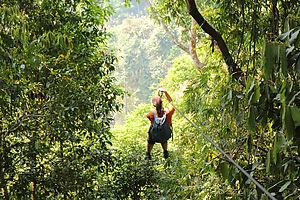 From Huay Xai we continued further east across Northern Laos. The
Lao road network is much less dense than in Thailand, so we couldn't
easily plan a route on secondary roads. Fortunately the main road
number 3 towards Luang Namtha was far from a busy highway, rather
resembling the countryside roads we had been cycling in
Thailand. The population density of Laos is less than a fifth of
that in Thailand, and only few people have cars. Heavily loaded old
trucks and minibuses occasionally unfreshened the air with thick
black clouds of exhaust while passing us, but the traffic density
was low enough not to bother us too much.
From Huay Xai we continued further east across Northern Laos. The
Lao road network is much less dense than in Thailand, so we couldn't
easily plan a route on secondary roads. Fortunately the main road
number 3 towards Luang Namtha was far from a busy highway, rather
resembling the countryside roads we had been cycling in
Thailand. The population density of Laos is less than a fifth of
that in Thailand, and only few people have cars. Heavily loaded old
trucks and minibuses occasionally unfreshened the air with thick
black clouds of exhaust while passing us, but the traffic density
was low enough not to bother us too much.
The road continued to go up and down large hills, with beautiful views down to the valleys on higher passes. The surface was paved and in good condition, a pleasure to ride. The land was partly covered by forest and partly deforested, with mainly Chinese and Vietnamese buying the wood. We saw many small rivers, which were generally cleaner than in Thailand, probably due to almost complete lack of any industry in the area.
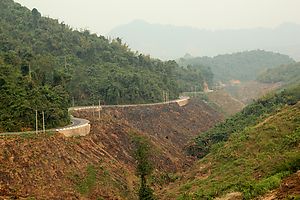 Both Lao and Thai people have a habit to burn patches of land,
often to prepare a field but sometimes with no apparent
purpose. Most of the burning happens between February and April,
which in combination of the long dry period makes the air misty and
dusty, like constantly being inside a thin cloud. It has not been
difficult to breathe but we have certainly felt the difference from
fresh and clear mountain air. We've also missed the blue sky, which
will only appear again when the rainy season begins in May or
June.
Both Lao and Thai people have a habit to burn patches of land,
often to prepare a field but sometimes with no apparent
purpose. Most of the burning happens between February and April,
which in combination of the long dry period makes the air misty and
dusty, like constantly being inside a thin cloud. It has not been
difficult to breathe but we have certainly felt the difference from
fresh and clear mountain air. We've also missed the blue sky, which
will only appear again when the rainy season begins in May or
June.
Roughly every five kilometers the road went through a small village. Children were happily waving and shouting "Hello" or "Sabaidee", often running to the roadside to meet us. They didn't have much but were laughing, playing and seemingly enjoying life. We rarely heard a child crying or anybody shouting in an angry voice. Adults were a bit more reserved but many still greeted us, staring, smiling and wondering why on earth were we pedaling all those uphills by bicycle when also motorcycles had been invented.
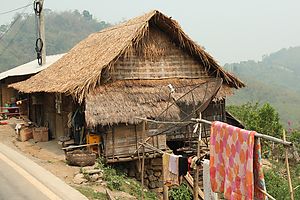 Most of the houses in villages were modest bamboo huts, probably
similar than they've been for hundreds of years, except being
nowadays equipped with electricity, tv and a satellite dish.
Cooking was still commonly done on fire and washing at the village
well. Here and there between the huts appeared fancier newer houses
built from concrete, especially in villages located near bigger
towns. Almost every village also had an elementary school, often
built with the support of some charity organization. That was the
situation in villages next to the main road. Rural villages tucked
between the mountains, many of them accessible only via narrow dirt
tracks, are apparently still less developed.
Most of the houses in villages were modest bamboo huts, probably
similar than they've been for hundreds of years, except being
nowadays equipped with electricity, tv and a satellite dish.
Cooking was still commonly done on fire and washing at the village
well. Here and there between the huts appeared fancier newer houses
built from concrete, especially in villages located near bigger
towns. Almost every village also had an elementary school, often
built with the support of some charity organization. That was the
situation in villages next to the main road. Rural villages tucked
between the mountains, many of them accessible only via narrow dirt
tracks, are apparently still less developed.
We cycled about 400 km from west to east via Luang Namtha and Oudomxay until Muang Khoua, a small town near the Vietnamese border. From there we took a two-day boat ride south on the Nam Ou river, finally joining the Mekong and arriving in Luang Prabang. The ride was very scenic, villages by the riverside only accessible by boat, fishermen, water buffaloes, small rapids, rock formations, sandy beaches and majestic mountains. Between the two days spent in the boat we stayed for two nights in Muang Ngoi, a riverside village transformed into a backpacker hangout as a result of all the boats stopping there. Despite the tourist crowds it was still a quiet and atmospheric place, having no cars and electricity only between 6 and 10 pm produced by a generator. That said, a new electricity line was just being installed and a road being built, which will certainly make a big change.
 In Luang Prabang we went to see some of the well-known sights. The
old and beautiful Xiengthong temple and the Kuang Xi waterfalls 30
km outside the city with idyllic turquoise pools were really worth a
visit. After that we headed again out to the countryside and started
cycling towards Phonsavan. The road was even a bit more mountainous
than earlier parts of our route, making some of the days quite
exhausting. Villages seemed to be a bit wealthier than in the
north, but ironically the first time children came to beg for candy
and money. It didn't happen often, but a few times during our ride
through the region.
In Luang Prabang we went to see some of the well-known sights. The
old and beautiful Xiengthong temple and the Kuang Xi waterfalls 30
km outside the city with idyllic turquoise pools were really worth a
visit. After that we headed again out to the countryside and started
cycling towards Phonsavan. The road was even a bit more mountainous
than earlier parts of our route, making some of the days quite
exhausting. Villages seemed to be a bit wealthier than in the
north, but ironically the first time children came to beg for candy
and money. It didn't happen often, but a few times during our ride
through the region.
Overall the pace of life in Laos is slow, slower than in Thailand. Selection in shops and on the markets is smaller, there is not much effort in arranging things attractively on the shelves and never a push to buy anything. Restaurants are serving more basic food, which however is usually tasty and not too spicy. Nobody seems to be in a hurry to go somewhere. This helps also the traveller to adopt a more relaxed and simple lifestyle. We will see how the atmosphere will change in a few days, during the celebration of Pi Mai, the Lao New Year. In addition to old traditions of cleaning homes and paying respect to the gods, the festivities include some wild partying and water throwing. In these temperatures being sprayed with water is a pleasure, so we're looking forward to joining and getting wet.
Wild elephants on the road
Posted: 2013-03-05 03:27:43, Categories: Travel, Thailand, Cycling, 787 words (permalink)
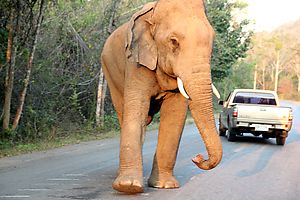 Sandra and I are now in Thailand and this photo shows one of our most exciting
moments during the first two weeks. We were riding a moped back from
Palau waterfall in Kaeng Krachan national park, when suddenly two
big wild elephants were walking towards us on the road. A Thai man
stopped his moped, turned around and adviced us to do the same. We
drove back a couple of hundred meters and watched how the beautiful
animals walked slowly forwards. One of them decided to return to the
forest, the other continued on the road.
Sandra and I are now in Thailand and this photo shows one of our most exciting
moments during the first two weeks. We were riding a moped back from
Palau waterfall in Kaeng Krachan national park, when suddenly two
big wild elephants were walking towards us on the road. A Thai man
stopped his moped, turned around and adviced us to do the same. We
drove back a couple of hundred meters and watched how the beautiful
animals walked slowly forwards. One of them decided to return to the
forest, the other continued on the road.
A car came from our direction and started slowly driving around the elephant. We followed behind the car together with the Thai motorist. Just as the car was passing, the elephant turned and started again crossing the road. The car and the Thai motorist got through, we weren't sure and stopped. Should we get off from the moped and slowly retreat on foot, or what should we do? Fortunately the elephant decided to stay in the middle of the road, leaving us enough space on the side. Sandra held her nerves well enough to point the camera towards the giant and take the photo.
We started our Thailand tour on the 14th of February by flying to Bangkok and taking a bus to Hua Hin. There we visited Sandra's father, who married a Thai woman after the early death of Sandra's mother, and who is now living in Thailand with his new family. In addition to meeting the family, Hua Hin was a good place to get adjusted to the climate, to try out Thai food and delicious fruits, to spend a bit of time on the beach, to enjoy a Thai massage, to visit a few temples and to get used to the left hand side traffic. The trip to Palau by moped was an exception, mostly we rode our bicycles which we brought with us.
After a week in Hua Hin we spent two days in Bangkok, which was a quite hectic experience after the more relaxed Hua Hin. We cycled once across the whole city from the western bus terminal to our hotel, which we had less wisely booked in the eastern part of Bangkok. After that we switched to public transport and walking. Once we rode motorcycle taxis, the fastest way to get around and an experience in itself. Of the most famous sights we went to see the big lying golden Buddha statue at Wat Pho, but skipped the Grand Palace. The backpacker oriented Khao San area was a bit more laid back, including roads without cars, with food stands on the side and foot massages outside in open air. We also shortly met my old friend Phisit, who kindly invited us for lunch near his workplace.
From Bangkok we took a train north to Phitsanulok and started our cycling tour. We rode first to Sukhothai spending one day around old temple ruins, and from there through the countryside and small towns towards Chiang Mai. Now we are at Chom Thong, near Thailand's highest mountain Doi Inthanon and the surrounding Doi Inthanon national park.
Especially smaller roads have been nice and motorists surprisingly polite. Cars and trucks mostly leave a large safety margin when overtaking us — sometimes vehicles coming from the opposite direction have to cope with a much less space than we do. People are yelling "Hello hello" from their houses when we're passing: the smaller the road the more attention we gather. A few times we've got spontaneous gifts such as bottles of drinking water or a watermelon. Unfortunately the locals' English ability is usually limited to the "Hello" and we don't speak enough Thai to really communicate with them.
Daily high temperatures are constantly over 35°C, and the sun shines strongly. We try to start relatively early in the morning and find accommodation latest early afternoon, leaving time to rest during the hottest time and to walk around later in the evening. Hotels and guesthouses are mostly easy to find, and cost around 400 Baht (10€) for a modern and clean room with air conditioning, less with fan only. Two times we stayed with CouchSurfing hosts, enjoying generous hospitality and learning more about the local culture and habits.
Staying connected in Thailand is quite easy nowadays. Almost all hotels and guesthouses have free wireless Internet. And when that's not available, we can use our one month / 1 GB mobile Internet package which we got for 500 Baht including the SIM card and some talk time. Phone calls with Thai SIM cards are cheap too, even when calling abroad. Roaming fees are absurdly high, so our Finnish and German cards we're keeping out of our phones.
From library to library on two wheels
Posted: 2011-06-18 14:55:49, Categories: Travel, Work, Ecology, Cycling, Germany, Cyc4lib, Denmark, 641 words (permalink)
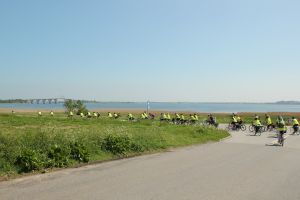 The Cycling for Libraries
tour was an experiment on what comes up in the minds of library
professionals when they go out and ride bicycles for nine days
together. Answer: far-reaching discussions about the future of
libraries in the changing world, and a great team spirit as the group
worked it's way 700 km from Copenhagen to Berlin.
The Cycling for Libraries
tour was an experiment on what comes up in the minds of library
professionals when they go out and ride bicycles for nine days
together. Answer: far-reaching discussions about the future of
libraries in the changing world, and a great team spirit as the group
worked it's way 700 km from Copenhagen to Berlin.
In the beginning we got to know each other and figured out by trial and error how to travel in a group. We saw beautiful Danish seaside landscapes, enjoyed meals prepared for us by our cook, were warmly welcomed in a local libraries, spent much more time on the road that the organizers had expected, got tired fixing punctured tyres in the rain, felt the bliss of a hot shower and slept side by side on the floor in a school.
After a couple of days the weather became more sunny, daily distances a bit shorter, bicycles were in better shape and also other topics than cycling and survival started to pop up in the discussions. As we didn't have books, documents or Internet in front of us, it was easier to think of broader topics than details. We talked about our projects, library politics, online presense and social changes — and of course about cycling, traveling and other hobbies.
The organizers had prepared for each day a theme, which was announced in the morning briefing. That guided the discussions a little bit, but ultimately it was up to each participant if they wanted to follow the theme, pick some other topic or simply listen to the nature and enjoy cycling. In the evening we were usually too tired and at the same time excited about what had happened during the day, that it was not easy to focus on any common theme other than food, beer and sleep.
A topic I found particularly interesting was the role of libraries as participants in social and environmental issues. One idea which came up was to create a global warming information finding aid: a shelf containing books, dvds and other resources on the topic, including hints what people can do themselves in everyday life. Libraries taking part in the campaign would place the shelf in a prominent place where visitors would easily see it. Different viewpoints should be offered to maintain the reputation of libraries as an impartial and trusted source of information.
Just as media can influence the thoughts and focus of its audience by choosing the topics to write about, libraries have more subtle but similar power through choosing which books and other resources are most visibly presented - including recommendations given by librarians online. Whether or not and how that power should be used is naturally not a trivial question. In any case, libraries can provide resources which give both a broader view and go deeper than a single TV show or newspaper article ever will.
One goal of the trip was to get library folks outdoors and challenge them. Several participants were first time taking part on a longer cycling tour. Accommodation was modest so people were together also in the evenings instead of locking themselves in hotel rooms. Day by day the team spirit grew, people helped each other and made sure nobody got lost or left behind. Everybody made it until the end, and many wrote afterwards that in their minds they were still cycling several days after the trip.
The Kirjastokaista team with their video cameras were with us during the whole tour. Almost everything was therefore freshly documented in detail and a short video of each day's events was posted online every evening. In that way the tour itself was an example of rapid information sharing using modern channels. A half an hour documentary is planned to come out later in the autumn. I'm looking forward to watching it.
Cycling for Libraries
Posted: 2011-05-28 10:49:39, Categories: Travel, Work, Ecology, Cycling, Cyc4lib, Denmark, 341 words (permalink)
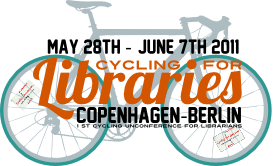 Today starts an interesting event called Cycling for Libraries.
About 80 library professionals and other people, whose work is somehow
connected to libraries, will be spending nine days cycling from
Copenhagen to Berlin. The goal is to combine work, fun and healthy
exercise outdoors in a new and exiting way. The welcome party was
yesterday evening at the Copenhagen main library, featuring a pedal
powered ice cream and coffee bar.
Today starts an interesting event called Cycling for Libraries.
About 80 library professionals and other people, whose work is somehow
connected to libraries, will be spending nine days cycling from
Copenhagen to Berlin. The goal is to combine work, fun and healthy
exercise outdoors in a new and exiting way. The welcome party was
yesterday evening at the Copenhagen main library, featuring a pedal
powered ice cream and coffee bar.
Cycling for Libraries is a moving conference, where the main focus will be on the informal discussions between talks and other organized sessions. Hey, those are often the most interesting bits in conferences anyway. There will be some seminars, workshops and visits at local libraries on the way, but most of the time the participants will create the event themselves. I'm curious to see how much of the discussions will be focused on library topics, how much on cycling and how much on everything else. The organizers don't have a clue either, they're also doing this the first time.
For me it'll be the second time to participate in a organized cycling tour. Cycling for Libraries will not be as ecological and down to earth as the Ecotopia Biketour I joined in 2006, but still relatively low on luxury for a professional event. Accommodation will be at campsites, hostels and schools. I like that — sharing the space in a dormitory room or in a tent is a good way to get to know each other.
It's also a great opportunity to get out from my home office. It's too easy to get stuck to routines there, and have too little communication with the outside world. I came to Copenhagen a few days in advance and have really enjoyed my time here. Almost everybody is moving around by bicycle and that gives a special spirit to the whole city. Already on the first day, crossing a canal on a big bridge together with dozens of other cyclists and only a few motorists, I had a great feeling of being part of the community.
Bicycle 40000 km celebration
Posted: 2008-06-26 13:40:50, Categories: Travel, Finland, Ecology, Cycling, 542 words (permalink)
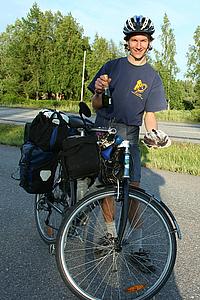 On Wednesday 18th of June, on the way to Åland islands together
with my Lithuanian friend Dalia, my bicycle reached 40000 km. Such a
happy moment was certainly a good reason for celebration, so we
offered it flowers, a cake which looked like a cycling helmet, and a
small bottle of sparkling wine. Well, the bicycle actually prefers
chain oil, so we helped it by eating the cake and drinking the wine
ourselves. It was a small bottle, so we weren't too drunk to ride
forwards after the party. :)
On Wednesday 18th of June, on the way to Åland islands together
with my Lithuanian friend Dalia, my bicycle reached 40000 km. Such a
happy moment was certainly a good reason for celebration, so we
offered it flowers, a cake which looked like a cycling helmet, and a
small bottle of sparkling wine. Well, the bicycle actually prefers
chain oil, so we helped it by eating the cake and drinking the wine
ourselves. It was a small bottle, so we weren't too drunk to ride
forwards after the party. :)
I had switched the cyclocomputer to show the total distance already twenty kilometers before the event. When it reached the magic figure, I squeaked the horn, we stopped and had a photo shoot and party on the spot. Very appropriately we happened to be on the King's Road, and there was a bicycle way next to the main road. People in the neighboring house were surely a bit curious what on earth we were doing, but they were too shy to come and ask.
The bike has now been in 22 countries and although it still hasn't traveled around the world, 40000 km is the equivalent distance. I bought the bike in May 2001 and have been riding it since then except for one year while being an exchange student in Japan 2002-2003 (I had another bicycle there). That makes an average of about 6500 km per year. Roughly half of it has been tours and shorter recreational outings, the other half being commuting and other everyday use. Everyday use includes also plenty of icy, snowy, slushy and rainy days during winters.
It's a year 2001 model of Nishiki Hybrid 601, a fairly standard decent quality hybrid bicycle. The frame, handlebar, brakes, gear shifter levers, front shifter, stand and plastic fenders (!) are still originals. Front fork, rims, crankset and pedals have all been changed once, rear shifter and seat twice. It's probably running about the eight chain and sixth rear cassette now, and the third set of chainrings in the front. It has the third set of summer tyres (not counting the originals which were crappy and quickly replaced) and second set of winter tyres. Brake pads and wires of both brakes and shifters have been changed several times. I have a habit of changing the brake wires once per year or at least every second year, even if they still look okay.
The luggage rack in the back is probably much older than the bike itself. I had two aluminum racks which both broke after about 15000 km. After the second breakdown I switched to a sturdy steel rack ripped from an old touring bike in Romania. Despite being slightly rusty, the current rack will probably last much longer than the previous ones. For touring, I've also added rear panniers, a handlebar bag (summer 2005), bar ends, a mirror (changed twice) and two drinking bottles. Last but not least, the bike is equipped with two locks, the cyclocomputer which shows speed and distance, a small funny horn, a seashell from the Black Sea coast and a collection of stickers from different countries.
Many people have asked whether the bike has a name. No, it doesn't, it's simply an old pal. But I just created a small picture gallery for it.

Copyright Arto Teräs <ajt@iki.fi>, licensed under the Creative Commons Attribution-Share Alike 3.0 Unported License. (Unless otherwise mentioned in individual photos or other content.)